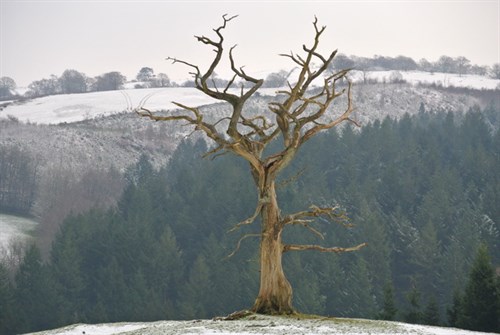At last November brings autumn colour on trees and shrubs
Saturday, November 30, 2013
First the headline news.
If you read the September News item you will know that we were
invited to submit an article about Cilgwyn Lodge for the online
Daylily Diary of the American Hemerocallis Society (AHS).
Each week in the winter months the Diary features a garden which
grows daylilies both within the USA and overseas (the AHS is a very
large plant society with a worldwide reputation and membership).
Those outside the USA are featured as International Garden of the
Week. It was our turn on 23 November (the first Welsh garden to
haven had the honour) and what a thrill it was to see our garden
posted on an American website. We have had many kind e-mails from
readers and can now give you the chance to see the article by
visiting www.daylilydiary.com
Now back to everyday life at Cilgwyn!
Keeping with the American theme, at this time of year Frank
Sinatra's bittersweet "September Song" always comes vividly to mind
as I reflect upon the gardening year and its imminent ending. Just
a few more precious and golden days before the curtain comes down
once again and the dark days of winter descend upon us. This year
it has arrived very late with the best leaf colour arriving
in the third week of the month and lasting for just a few days:but
what tremendous colour! Not just on garden trees and shrubs but on
all the native trees in the surrounding countryside.
A few images to give a flavour of what we have experienced at
Cilgwyn this month.
Acer palmatum "Orange Dream" Picture taken Tuesday 19
November when leaves first coloured.

Three days later most of the leaves had fallen making a
wonderful contrast with the green marbled leaves of the
underplanted cyclamen hederifolia
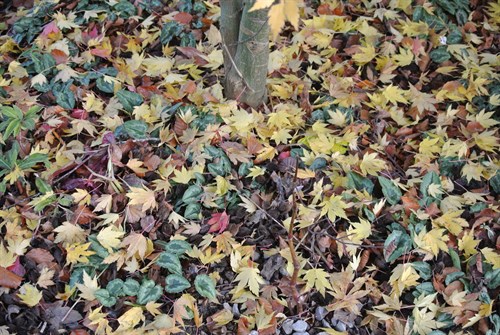
Acer palmatum (label long since lost!) Unlike the one
above this one still has most of its red leaves 2 weeks
later!
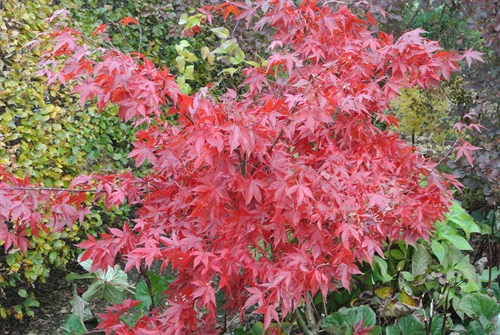
Hydrangea "Preziosa" showing wonderful almost black leaf
colour. It is of undetermined parentage but colours up well like a
good serrata. It has been in the garden for several years but it
has never taken on these hues before.
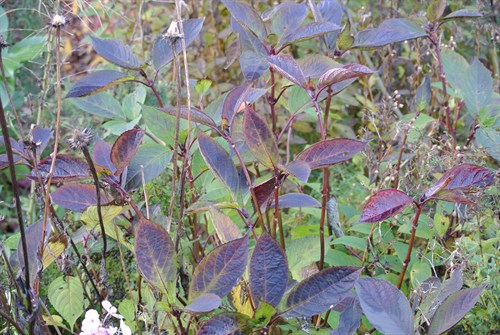
Miscanthus sinensis "Overdam"catching low, late
afternoon sunshine. A tall, tidy, stately form of this invaluable
hardy grass
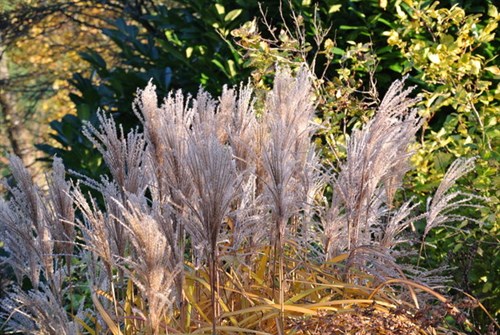
And a little quiz (answer at the end) - this is a
seedhead of what plant?
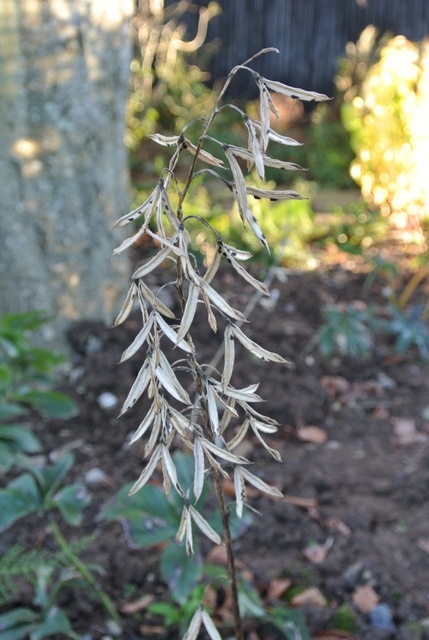
The abnormally long slide from summer to late autumn has given
plenty of time to start the process of "putting the garden to bed"
and to get under cover all the tender plants in pots. Cuttings have
been taken in abundance, a wide variety of seed gathered and
divisions of hardy perennials made and potted up for next
year.
Fallen leaves this year have been easily managed thanks to the
loan of a powerful leaf blower from our friend Rob, the "lawn
guru". As usual I have saved plenty of leaves to mulch the many
tender plants like agapanthus, salvias and impatiens planted in the
borders. With good drainage throughout the gardens and the extra
insurance of the mulch, we usually get all our tender plants
through for next year.
Here I am feeling like James Bond ready to take
off any minute!
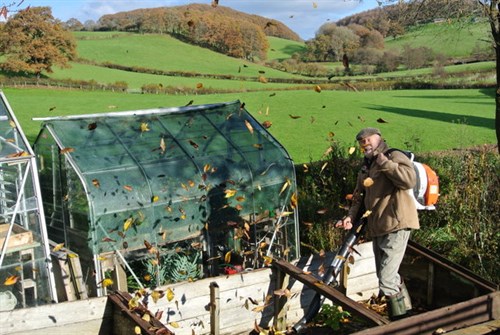
As to the best time to cut back the spent growth on herbaceous
perennials there is no definitive answer. Every gardener seems to
have their own ideas; some cut back in autumn to tidy the garden
and get off to an early start in spring whereas others (me
included) prefer to wait until late winter. We all have our own
reasons. Mine are fourfold: firstly I have so many other things to
do in autumn I never have sufficient time, secondly the seed heads
on spent perennials are an important early winter larder for
wildlife, especially birds, thirdly the spent flowerheads can
look fabulous when laced with ice or snow, and finally the
retention of all the dead growth does provide some measure of
protection for the dormant plants in a prolonged cold winter.
Gunnera is the one plant I always cut back before the
worst of the frosts arrive. The spiny stems up to 2" in
diameter are easily cut through with a pruning saw. Sad to see such
a noble plant laid low, but covered with it's own leaves it will
survive the coldest winter. If you come from Brazil you need to
wrap up well!!
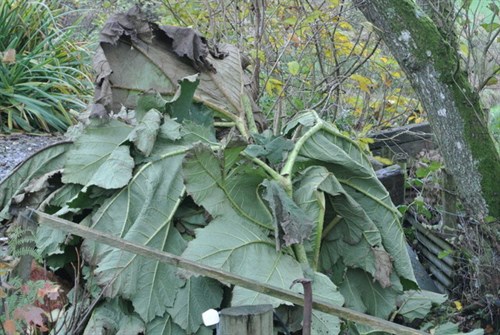
I only have one plant to cut back but at Trebah Gardens
in west Cornwall they have 100's to cut back and what an
architectural statement it makes.

Weather
The usual November mix, remaining mild until mid month but very
wet and windy at times. Max temperature 15C. Then the first real
frost on the 13th followed by increasingly colder weather day and
night, below the seasonal average. 5 frosts so far with a min of
-6C on the 23rd. A few flakes of snow and lying snow for a time on
the surrounding hills above 750feet.
With several Min/Max thermometers stationed at intervals
throughout the gardens it is interesting to compare the climate
zones. The top end of the House Garden can often be 4C warmer than
the lowest part of the Paddock Garden nearest the river just 90
yards away. It is always said that frost goes to water and these
crude statistics would appear to support the country lore!
Garden update
The garden has slipped gently into winter mode after a colourful
start to the month. There were still some asters in bloom (in
particular a, frickarti "Monch" which had been in flower for
nearly 4 months, a.turbinellus and a.horizontalis "Lady in Black),
dahlias, several forms of hardy chrysanthemums, some really
good saxifraga fortunei cultivars that had enjoyed the mild damp
conditions, hardy fuchsias and a great late show on many
hydrangeas. still throwing up new flowers well into the month, some
with great autumn leaf colour too. One thing however is clear is
that members of the daisy family hate heavy rain. Within a few days
of its arrival most of the them simply came to an abrupt end. Hardy
geraniums however prove their worth at this time of year. We still
have a few oxonianums, sanguineums, "Anne Folkard" and the "Plant
of the Century" "Roxanne" still setting new flower buds!
Saxifraga fortunei "Pink Mist" - dainty, floriferous and
long flowering
 .
.
Leaf clearing is an essential task especially from the lawns
which had their last cut and autumn feed on the 8th. Digging up
large and precious tender perennials for potting up and storing in
the tunnels and continuing taking cuttings are other essential
tasks to complete before the winter sets in.
We have had superb crop of root vegetables some of which have
been harvested for winter storage (carrots, beetroots, celeriac and
Japanese radish). Others like swede, parsnip, salsify and turnips
we leave in the ground to harvest as we require. Including
brassicas, salad leaves, tomatoes,peppers and a section of dried
and frozen veg., we have 20 varieties to choose from.
The best of the carrots (Kingston and Resisitafly)
celeriac (essential to sow it under protection in early February),
and beetroot Boltardy a good old fashioned and long keeping
variety. (this of course is a selection of the very best!)
Would I show you all the forked carrots of which there were
plenty?!!
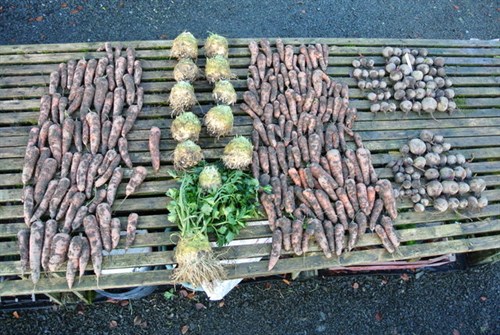
Autumn leaf colour has been superb for just a few days with some
of the newer acer introductions colouring properly for the first
time. As most plants fade into dormancy the winter stars are
beginning to come into their own. A few early flowers on cyclamen
coum, flower buds appearing on helleborus foetidus, sarcacocca too,
swelling buds seducing us with the prospect of intense scent on the
coldest of winter days
What's looking good?
The polytunnels are the place to look! The protection they
afford with heat on colder nights greatly extends the season at the
back end of the year. They are a lovely place to be especially on a
cold, dark, wet day. Currently in flower we have brugmanias.
chrysanthemums for cutting, salvias, impatiens, justiceas, a few
fuchsias, cestrum newellii, some dwarf alstroemerias, nerines and
plectranthus. The last of the tomatoes are hanging on, some still
setting on the 14th truss of "Rosada" the superb plum fruited
variety that I have raved about in previous news items. Also
continuing to flower is hedychium "Luna Moth" I mentioned last
month. Not only have new stems started to produce flowers but stems
that previously flowered are starting to flower again at the tips
where the old flowers appeared to have finished. In my experience
of growing hedychiums this is most unusual.
Plectranthus zuluensis. This plant is an interesting
member of the lamiaceae which I first purchased in the
early 1990's from Healings Mill in Gloucestershire. Cuttings are a
piece of cake from which plants can make a bushy shrub in one year.
In the sub tropical areas of the southern hemisphere particularly
South Africa, India and Australia which are their stronghold there
are over 300 species and numerous cultivars. Closely related to
coleus (now solenostemon) they require winter protection. P.
zulensis is one of seven types I grow and in my experience it is is
the most reliable one flowering from May to December (there's that
Frank Sinatra song again!).

Tender nerine sarniensis in a pot in the large
tunnel.
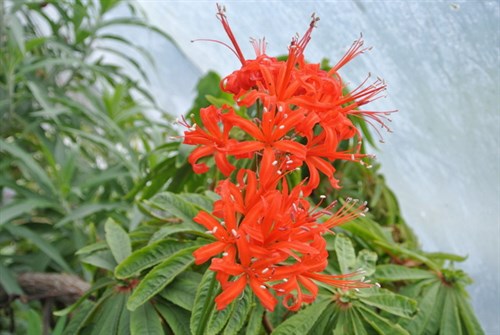
Can you believe this hosta "El Nino" still looking in
prime condition in the middle of November long after all the other
200 in the gardens have started to fade.

I must finally make a mention of the fact that for the first
time a brugmansia planted outdoors in a sheltered spot flowered
this month. There were 8 flowers in bloom and whenever frost was
forecast I dutifully covered them with thick layers of the
indispensible horti -fleece (often at some ungodly hour!). Sadly
the minus 6C brought the show to an abrupt end as it did to the
amazing display of the cobaea scandens scrambling over the shrubs
by the conservatory.
The brugmansia in flower alongside the red
Abysnnian banana shortly before the frost got
them.
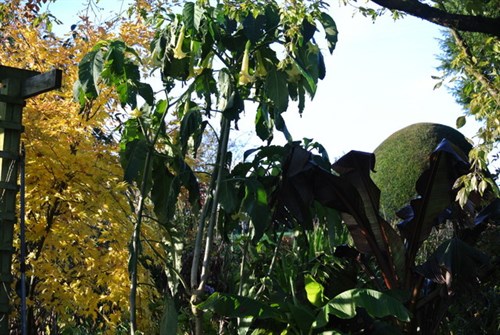
Wildlife and countryside
This month the highlight was the autumn colour on the native
trees in fields and woodland all around us. There are
some very good berries in profusion on the hollies which is
due to the absence of any fieldfare and redwing migrants from
Siberia (so far). Also missing are the large flocks of
starlings which are usually common by now.
Local forest with European larch in full autumn
glory. We are lucky that so far the dreaded phytopthora disease
which is ravaging some forests in Wales has not yet reached
us.
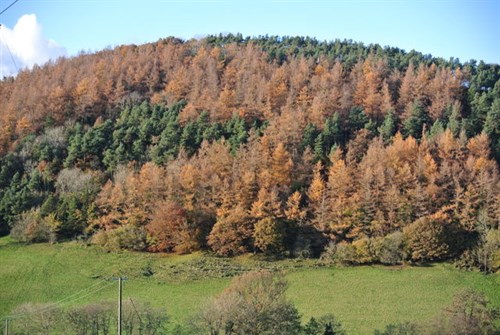
Cilgwyn Lodge looking across the Paddock Garden. The
yellow autumn colour it the righty hand side is from a Wych Elm
which we treasure as there are so few left here. They get so big
then the Dutch Elm Disease catches up with them. Fingers
crossed.
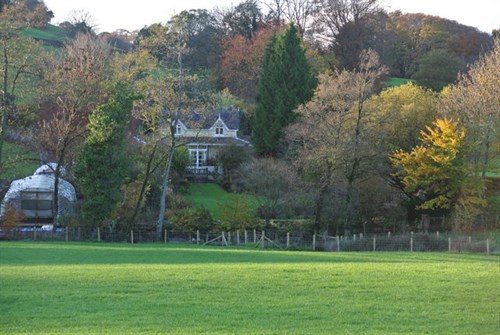
Our friends the robins are constant companions when working in
the gardens, closely followed by the blackbirds which were in
continuous attendance when I dug the root crops a couple of
weeks ago -plenty of juicy worms to feast on! There are also some
very inquisitive wrens around the house where all the little nooks
and crannies provide a food source, an ideal refuge from the frosty
nights and protection from predators. Because of their light body
weight they are highly susceptible to intense cold and were almost
wiped out by the Big Freeze of 1962/1963 especially and several
times since then.
An unusual and highly unwelcome passing visitor last week was a
cormorant flying over the Paddock Pond on its way back to the sea
30 miles away after a day no doubt of plundering fish stocks on the
upper River Towy. Fortunately it didn't stop off at the "Paddock
Pond Takeway" as one did some years ago at Christmastime.
Rabbits continue to plague the gardens chewing plants and
digging holes everywhere. They have developed a taste for Brusssels
Sprouts, chewing the more accessible ones back to the stem.
Finally two examples of the strength that small creatutres
posess. When blowing the leaves off the lawns I wondered why unlike
most leaves a few didn't readily blow away. On closer inspection I
discovered the answer. Worms had begun to drag them underground and
compared to the size of a lobworm, a leaf from a cherry tree is a
big challenge. However in some cases the leaves had already been
dragged partly into the worm hole and in such position were tightly
anchored. We always know what worms do to improve the quality of
soil and here was living proof.
The other occurred when pressure washing the greenhouses. If you
own a greenhouse you will know just how many spiders webs there are
by the end of the season and welcome they are too removing large
quantities of troublesome pests in a wholly organic way. Now that
the spiders have gone into dormancy the cobwebs are removed by the
force of the pressure jets - or are they? It is amazing just how
resilient the cobwebs are. Even a single strand can take the full
blast of a jet at close quarters and still remain intact. Nature
can make you feel very humble!
Visits and visitors
Two talks this month at opposite ends of Wales. One for the
local gardening club at Newquay in West Wales beloved of Dylan
Thomas whose Centenary year this is, and the other at Usk in the
east for Monmouthshire Group of The Hardy Plant Society. Both
talks very well received, the one in Usk generating much good
discussion from many experienced veg. growers which highlighted the
wide range of perennial vegetables available to home growers - over
50 listed on some websites. Visit www.perennialveg.org.uk for
more info. One more talk in December at our old friends Brecon and
District Horticultural Society for their Christmas meeting
and then a really wide range of talks and venues in the
New Year including The Llandysul Winter Gardening Weekend in
February and our first talk in England to a Group meeting of Dorset
Hardy Plant Society. Exciting times ahead!
In 2014 for the 15th time, we shall once again be opening for
The National Gardens Scheme for by appointment visits between June
and September. Although this may seem a rather formal arrangement,
it is simply a way of managing our visitor season so that we can
cope more easily with the number of visitors at any one time, and
with more limited numbers than an Open Day, it gives a better
visitor experience. Please do get in touch if you would like to pay
us a visit, especially if you are coming a long way or planning a
trip in July which is our busiest month.
Seed heads of clematis tibetana var.vernayi a
member of the tangutica group well known for its long lasting
seedheads

On the subject of seed heads the answer to the quiz
question I posed earlier is hosta. Hope you got it
right!
One last rather sad piece of news. For many years
visitors have expressed delight at the silver skeleton of a long
dead oak tree at the top of the hill behind the Lodge. It made a
dramatic architectural statement in an absolutely perfect spot.
Recently it had become dangerous to livestock with falling limbs so
my neighbour Ifor had no choice but to remove it, roots and all.
Amazingly it had been growing in less than a foot of topsoil on
shale, so it did well to reach maturity. Thanks for all the
pleasure you gave old friend.
